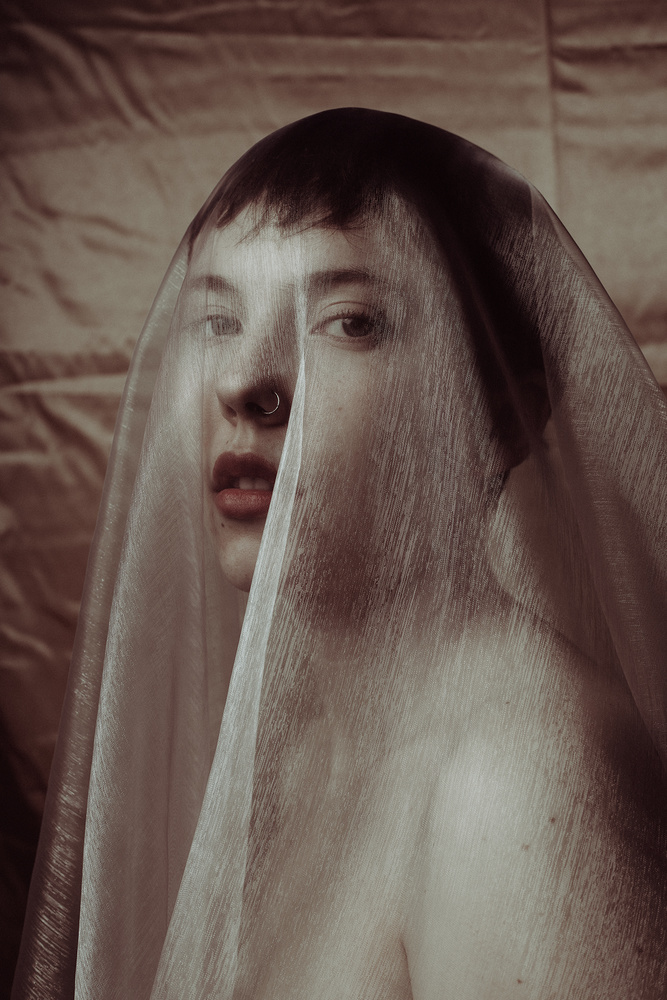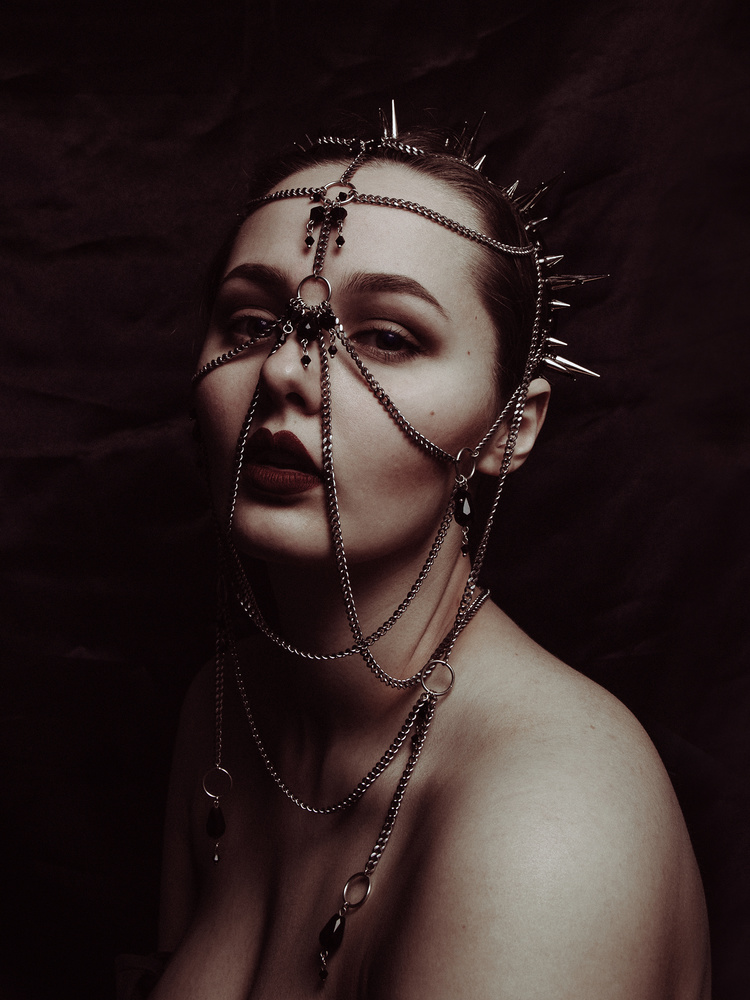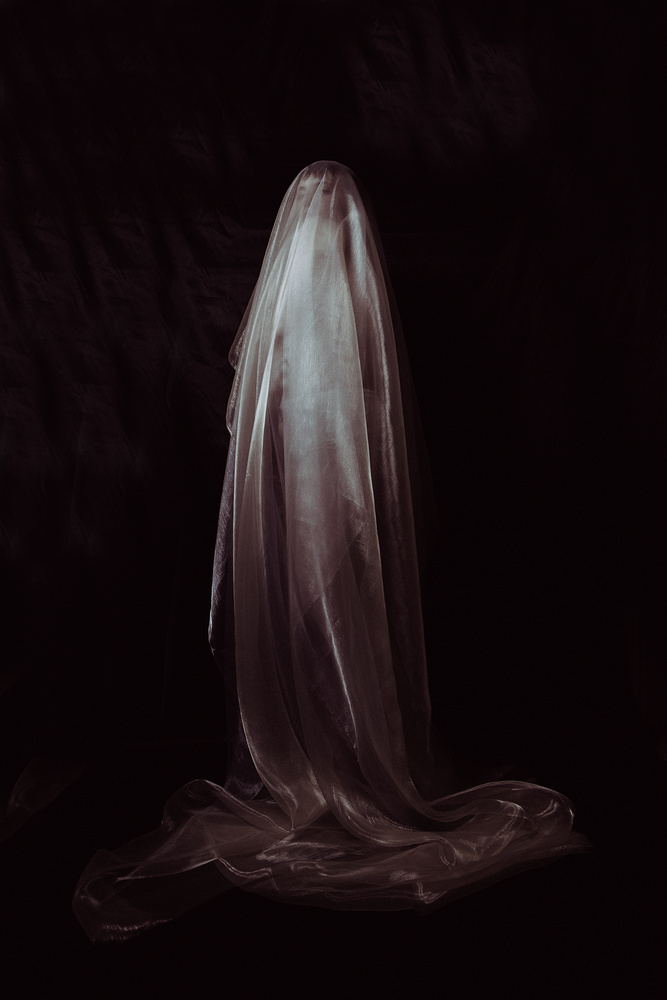Molly Baber is a multi-disciplinary visual artist and fashion photographer creating conceptual works that evoke blood, death, and feminine power, as well as a subconscious fantasy through ritual, divination, and mythology.
Currently based in Brighton, UK, she is inspired by the macabre, occult, and women's rituals. Baber is forever expanding her craft by assisting other photographers, working on film sets, collaborating with artists, and exhibiting personal works across the UK and Europe. In 2019, she was awarded "Best Emerging Talent" at the B3 BEN Awards at the Frankfurt Buchmesse, alongside co-collaborator Lena Chen, for their art film "Expose Her." Her lens-based work focuses on artistic, emotive portraiture, storytelling, and natural forms. Since living in the rural countryside of Berlin, solo adventuring around the United States, and further expeditions around Europe, Asia, and Central America, she has been left with a passion for exploration, discovery, and connecting with fellow creatives.

Baber started off her creative journey by using disposables as a kid; she had countless childhood photo albums, mainly consisting of her cats. She bought her first digital point and shoot camera when she was 13, which came with free editing software similar to Photoshop. Baber started doing photoshoots with friends, dressing up and painting themselves with abstract makeup. She was obsessed with America's Next Top Model and fashion magazines at the time, so her influences probably stemmed from that. She would watch retouching tutorial videos for fun and began editing the photos of her and her friends, as well as celebrity photos she found on the internet.

Baber then used photography as part of her art classes at school and A-Level photography at sixth form college, where she did analog processes., falling in love with shooting still life, cemeteries, museum exhibit graves, taxidermy specimens, and skeletons on 35mm film. Baber would then develop and manipulate them in the darkroom. She says she had a fascination with the macabre and the transition between life and death from very early on in her artistic practice. Baber also studied A-Level Fine Art digital photography (mostly self-portraits) to create reference imagery for paintings. She would focus on dramatic and haunting portraiture, influenced by pop-surrealist artists such as Mark Ryden and Tom Bagshaw.
 It wasn't until around 2014 that Baber started using models in her photography. A walk around a gloomy, misty lake at dusk gave her the urge to shoot there with a ghostly feminine figure, something she had never done before. The emotion and atmosphere that could be captured by adding a living person into the frame rather than skeletal remains excited her. From then on, she began frequently shooting with friends and local models in abandoned buildings, cemeteries, and fields. Photographers such as Emily Soto and Nona Limmen became Baber's most significant influences at this time and are still two of her favorite practitioners.
It wasn't until around 2014 that Baber started using models in her photography. A walk around a gloomy, misty lake at dusk gave her the urge to shoot there with a ghostly feminine figure, something she had never done before. The emotion and atmosphere that could be captured by adding a living person into the frame rather than skeletal remains excited her. From then on, she began frequently shooting with friends and local models in abandoned buildings, cemeteries, and fields. Photographers such as Emily Soto and Nona Limmen became Baber's most significant influences at this time and are still two of her favorite practitioners.
 In 2015, Baber moved to Berlin and became immersed in a group of fine art photographers and models. She started a photography blog to document her experiences shooting models behind the scenes, assisting photographers, and a series of abandoned sites for the Urban Outfitters blog. As her love for travel grew, she became fascinated with landscape photography. She began mixing her love of darkness, gothic fashion, and rugged scenery. Baber became captivated by the feeling and story that haunting figures created within the fictional world. Eventually, in 2016, she applied to study for her BA (Honors) Fashion Photography at Falmouth University. It was here that Baber truly started to bring fashion into her work as she began to collaborate with designers and saw it as more of a career path.
In 2015, Baber moved to Berlin and became immersed in a group of fine art photographers and models. She started a photography blog to document her experiences shooting models behind the scenes, assisting photographers, and a series of abandoned sites for the Urban Outfitters blog. As her love for travel grew, she became fascinated with landscape photography. She began mixing her love of darkness, gothic fashion, and rugged scenery. Baber became captivated by the feeling and story that haunting figures created within the fictional world. Eventually, in 2016, she applied to study for her BA (Honors) Fashion Photography at Falmouth University. It was here that Baber truly started to bring fashion into her work as she began to collaborate with designers and saw it as more of a career path.
 Baber's work has a very painterly feel to it. She believes this comes down to the lighting, makeup, and color toning in post-production. She uses Lightroom primarily for her color work but recently has been transitioning to Photoshop to gain more control. Baber also likes to play around with the use of prisms in-camera, which distort and fragments the photograph and also add to this painterly quality.
Baber's work has a very painterly feel to it. She believes this comes down to the lighting, makeup, and color toning in post-production. She uses Lightroom primarily for her color work but recently has been transitioning to Photoshop to gain more control. Baber also likes to play around with the use of prisms in-camera, which distort and fragments the photograph and also add to this painterly quality.

As well as photography, Baber has recently been working on a new film with her creative partner, Lena Chen. "Expose Her" tells the story of one woman's two identities, birthed from an experience of trauma, and the other lives she leads with different lovers. They exhibited the short film in a competition in which they won an award for the piece. Their overall goal is to turn it into a feature-length film. Baber and her creative partner are also working on a three-part conceptual fashion film series, retelling ancient rituals from a feminist perspective., the first of which, "Starfire," has already been exhibited in cities. Baber plans to continue video as a storytelling medium, as the sequencing process is so different from a photo series. She is discovering that directing, editing, and color grading is something she loves and can't wait to pursue it further.
 Baber's inspiration works in different ways; sometimes, it's through collaboration, and other times, it's based on a theme she has a current obsession with (e.g., earth rituals, Victorian post-mortem photography, divination) or a personal experience that has struck her. Baber has an ongoing list of topics and ideas that she refers back to and adds to always. Baber looks online and in books, keeping notebooks and Google Docs of links, books, quotes, and conceptual thoughts and visual ideas. She refers to fashion magazines and other artists' work and makes mood boards for visual concepts. She then begins test shooting. Baber has also used discussion groups and interviews to conduct research. Most of the time, her projects are scattered with ideas at the beginning, and they become more focused as they progress. There is usually an epiphany moment when she realizes the message or story she wants to portray.
Baber's inspiration works in different ways; sometimes, it's through collaboration, and other times, it's based on a theme she has a current obsession with (e.g., earth rituals, Victorian post-mortem photography, divination) or a personal experience that has struck her. Baber has an ongoing list of topics and ideas that she refers back to and adds to always. Baber looks online and in books, keeping notebooks and Google Docs of links, books, quotes, and conceptual thoughts and visual ideas. She refers to fashion magazines and other artists' work and makes mood boards for visual concepts. She then begins test shooting. Baber has also used discussion groups and interviews to conduct research. Most of the time, her projects are scattered with ideas at the beginning, and they become more focused as they progress. There is usually an epiphany moment when she realizes the message or story she wants to portray.
Always stick to your vision, but be aware that it may not be for everyone. Discover the art that excites you, visit museums and galleries, travel and explore places that intrigue you visually, and get inspired! Create for you.
Baber says she is finding that staying true to her style, although it is a niche, is having its benefits, as those designers whose work she admires are approaching her to shoot for them.
 Baber has a new editing workflow. She makes her initial selects with Adobe Bridge and brings them into Lightroom to start experimenting with color and see which photos are grabbing her attention. Making various versions of her favorite selects and comparing them, she looks for differences in things like tone, saturation, and light and dark areas. Baber thinks the color grade is vital, and that part takes her the longest time. She mentions she can get quite indecisive, as the smallest change makes such a big difference to the overall mood of an image. Once she has made the final selection, she will then take the raw file into Photoshop to make any retouching adjustments and then either bring it back into Lightroom to add color adjustments or recreate and refine the color grade in Photoshop.
Baber has a new editing workflow. She makes her initial selects with Adobe Bridge and brings them into Lightroom to start experimenting with color and see which photos are grabbing her attention. Making various versions of her favorite selects and comparing them, she looks for differences in things like tone, saturation, and light and dark areas. Baber thinks the color grade is vital, and that part takes her the longest time. She mentions she can get quite indecisive, as the smallest change makes such a big difference to the overall mood of an image. Once she has made the final selection, she will then take the raw file into Photoshop to make any retouching adjustments and then either bring it back into Lightroom to add color adjustments or recreate and refine the color grade in Photoshop.

Out of all her projects, one made a significant impact on her career so far. Baber feels the Tarot project still feels relevant to her. She started the series in 2018, and it kickstarted collaborating with other designers, stylists, and makeup artists. She originally made the series into a book; however, recently, she turned the series into postcards and brought them into a ritual setting, where she let people use them for divination purposes. Seeing them used in their intended way was a magical moment for Baber, and now, she is even more set on finishing the series and creating a full tarot deck.
 "Minerva" (2018), a film project in collaboration with artists Lena Chen and Erica Merritt, was also incredibly impactful for Baber. The concept came from alternative family models and utopian visions of raising children in the future. The process was a significant learning experience. She traveled to Berlin, Utrecht, and Stockholm to facilitate workshops and discussion groups with the public, conducted interviews, and filmed and edited the piece. The final work was a video projection installation, exhibited at Drone Dancing, Färgfabriken, Stockholm. Baber performed on the opening night with Lena, something she had never done before, which has led to the planning of future performance work. There, they met Alex Weber, who became their sound designer for both the recent film projects "Starfire" and "Expose Her." She also met her girlfriend during that exhibition. She has revisited Stockholm many times since and is even considering moving there. So, she says she has a lot to thank that project for.
"Minerva" (2018), a film project in collaboration with artists Lena Chen and Erica Merritt, was also incredibly impactful for Baber. The concept came from alternative family models and utopian visions of raising children in the future. The process was a significant learning experience. She traveled to Berlin, Utrecht, and Stockholm to facilitate workshops and discussion groups with the public, conducted interviews, and filmed and edited the piece. The final work was a video projection installation, exhibited at Drone Dancing, Färgfabriken, Stockholm. Baber performed on the opening night with Lena, something she had never done before, which has led to the planning of future performance work. There, they met Alex Weber, who became their sound designer for both the recent film projects "Starfire" and "Expose Her." She also met her girlfriend during that exhibition. She has revisited Stockholm many times since and is even considering moving there. So, she says she has a lot to thank that project for.
 Baber has advice for anyone starting.
Baber has advice for anyone starting.
You don’t have to focus on just one thing. I have bounced around multiple mediums, such as music and photography, and have always felt like I had to pick one to put all my time into and be successful in. I’m learning that creativity is an ever-evolving process, and it doesn’t always mean sticking to one area.
Baber sticks to this advice when she gets a creative block. She advises to switch to something else (e.g., painting, music, video), and photography will come back when the time is right.

In the future, Baber plans to continue with current work and concepts, the film projects and Tarot cards, as well as her most recent personal photography project, "Unearth" (2019), which discusses death, ritual, and mythology. Baber would love to immerse this project into the death positivity movement. She has also been involved with the Heal Her Project, a collective creating safe spaces for survivors of sexual trauma through transformative storytelling, collective ritual, and participatory art workshops. She has also been photographing Heal Her events across London and Germany and through the project will be ArtLake Festival this summer. She plans to create a Goddess series, photographing participants and workshop facilitators in an exercise in which they embody their inner goddess. Collaborating with makeup artists, stylists, and artists they have in the Heal Her team, participants will create their armor, accessories, and amulets and have the platform to become whoever they want to be. She also mentions she has also been collaborating with illustrators and graphic designers and would love to create more multimedia works in the future.
 In 10 years' time, Baber hopes she will be surrounded by cats, a pup, and a studio full of witchy goodness and creating art with people who are passionate about what she wants to create. She would love nothing more than to be working with fashion brands, jewelry designers, magazines, and galleries, creating both video and photographic works. Baber also wants to team up with nonprofit organizations, creating art spaces and events for causes she is passionate about.
In 10 years' time, Baber hopes she will be surrounded by cats, a pup, and a studio full of witchy goodness and creating art with people who are passionate about what she wants to create. She would love nothing more than to be working with fashion brands, jewelry designers, magazines, and galleries, creating both video and photographic works. Baber also wants to team up with nonprofit organizations, creating art spaces and events for causes she is passionate about.
All images used with permission of Molly Baber.







I think her work is amazing. A wonderful example of someone persuing her vision with passion and perseverance. Respect.
Thank you very much! I really appreciate your kind words! :)
From a technical place these are great shots, creative, and well styled. It's just not a style I'm super into, but the bnw shot is superb.
Enjoyed the pictures very much. Creativity of a different flavour. Thank you :)
I think this shows that photographers don't necessarily need to have a strict style, when each image has its own thematic concept. To me, this marks the difference between a genre-photogorapher and a photographer with an artistic vision. Quentin Decaillet's portraits don't feel like like portraits to me. They're not trying to tell a story through the model, but through the concept.
Love this article, and all the shots!